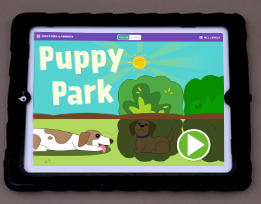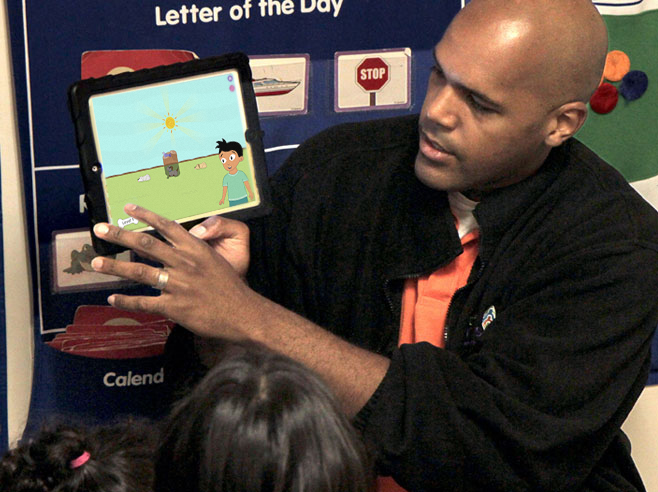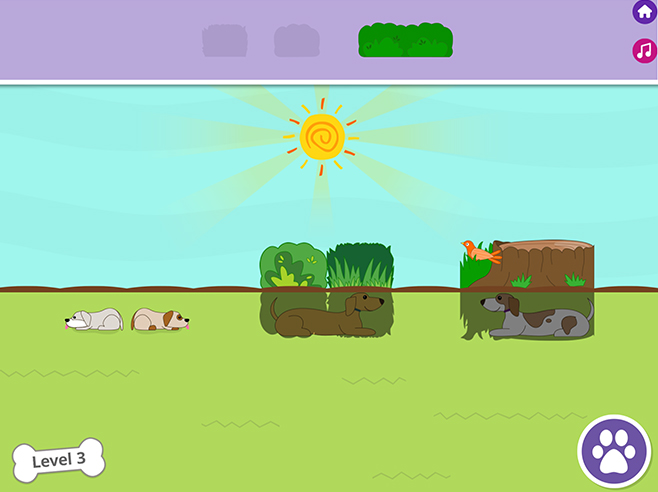Children explore creating shadows to provide shade for the dogs to help them stay cool in the hot, sunny park. Children arrange and stack objects to create small, big, tall, and wide shadows, depending on the size and shape of the dogs.
Materials

- Puppy Park app on iPads (1 device for Circle Time; 2–4 for Learning Centers)
- Projector (if available)
Preparation
- Familiarize yourself with the Puppy Park levels 1–12.
- If you prefer to use the app without music during parts of the game, tap the pink “music” button to mute all music.
- Note: Children are progressively challenged as they work through the 12 levels in the Puppy Park app: 1) the number of dogs needing shade increases, 2) different-shaped objects to create shade are included, 3) objects made of different materials are added (bushes, trees, bricks), and 4) the way children can place objects gets more complex.
- Levels 1–2. Introduce the app and how a shadow appears on the grass when small and big bushes are placed on the dirt. Describe how a shadow is made. Children create shade for 2 to 3 dogs.
- Levels 3–6. Children choose small, big, wide, and tall bushes to make different-sized shadows that will provide shade for 3 to 6 dogs.
- Levels 7–9. Children are introduced to a new material—bricks––that they stack on top of each other to make bigger shadows. They move bushes and stack bricks to make shade for 4 to 7 dogs.
- Levels 10–12. Trees are added to the materials children can choose from to create shadows. Children move around bushes, bricks, and trees to create shade for 7 to 10 dogs.
Directions: Lesson 8
Circle Time: Introduction
This game is introduced in a whole-group activity. Use a projector or hold the iPad as you would a picture book for the group to see. Children will also explore the game independently at the Learning Center.
In each level you introduce, listen to the app audio and ask selected children to follow the prompts. Engage the group in a conversation, using science and engineering discussion prompts such as those below to continue exploring.
Invite children to explore how shadows are made and how they can change when the objects blocking the light are moved or combined with other objects. Have them listen as Nor introduces the Puppy Park app. Spark their curiosity: Are you ready to help solve the dogs’ problem? Let’s create shade to help them cool off!
- Level 1. Ask children if they are ready to make shade to help the dogs cool off! Tap the green play button. Possible discussion ideas:
- What happens when the clouds move away from the sun?
- Why does the dog in the middle look happy?
- How can we help the other dogs cool down?
- Notice how Nor drags a bush from the purple section at the top of the screen onto the dirt.
- What happens when Nor moves the bush onto the dirt? Have a child drag a bush to place it on the dirt.
- Why did a shadow appear on the grass?
- Does the bush make a shadow that creates shade for the dogs? Tell children they can drag and plant the bush in another part of the park if the shadow is not shading the dogs.
- When children need help, have them tap the purple “paw” button. They can use the dotted line that appears to help guide where to drag the bush.
- Point to a dog that is in the shade.
- Ask children if there are any dogs that are not in the shade. How can you help those dogs?
- Have another child drag and plant another bush to create shade for another dog. When all the dogs are cooling off in the shade, tap the purple paw button.
- Look at how happy the dogs are in the shade! Tap the green play button to go to the next level.
- Levels 2–3. Children continue to choose bushes to plant in the dirt and design a park that makes shade for the three dogs. Wide bushes are introduced in Level 3. Ask children to notice the different sizes of the bushes in the purple section that they can plant in the park.
- Which bush will make a shadow that will shade the small dogs?
- How will you make a big shadow that will shade the big dog? Let’s try it. Have a child drag the small bush over to the big dog. Did that make enough shade to cover the whole dog? Why?
- How can you fix your park design so that the big dog is in the shade? If needed, prompt the child to place another bush next to it or choose a different (wider) bush.
- Remind children to tap the purple paw button if they need help.
- When the park is successfully designed so that all the dogs are happily cooling off in the shade, tap the green play button to go to the next level.
- Level 4. Notice the tree in the park. Have a child trace the tree’s shadow. Explain that since the tree is big, it blocks a lot of sunlight to make a really tall shadow that reaches the dog near the end of the park.
- Point out the tall bush in the row of bushes children can choose from.
- Where do you think we should plant the tall bush?
- Which dogs need a big shadow to make shade that will cover them?
- Have a child drag the tall bush to the dirt. Is the shade covering the dogs?
- Tell children to move the bushes back to the row or plant them somewhere else in the park if their design is not working.
- What happens to the shadow when you move the bush back to the row of choices?
- Why do you think that happens? Can you plant that bush somewhere else to make shade for the dogs?
- Levels 5–6. As different-sized bushes and more dogs are added, the solutions become more complex. Encourage children to choose another bush or add bushes together to find a design that works.
- Have children describe the different bushes they can choose from. Point to a dog and ask a child which bush they think would make a shadow big enough to shade the dog. Why did you choose that bush? Have the child plant the bush in the dirt.
- Did the bush make a shadow big enough to shade the whole dog? If not, prompt the child to try a different bush or bushes.
- Have volunteers take turns planting bushes in the dirt. Remind them to tap the paw button if they get stuck.
- Why did you use a tall bush to shade those dogs?
- What happens to the shadow if you plant two small bushes there?
- Once the park design has all the dogs cooling off in the shade, acknowledge children for solving the dogs’ problem. Great job solving the dogs’ problem! Look how happy all the dogs are now that they are in the shade.
- If time runs out before all children get a chance to participate, tell them they will have an opportunity to work on the Puppy Park app in the Learning Center.
Learning Center
- Encourage children to listen to and build on each other’s ideas as they explore the Puppy Park game in pairs or individually. Observe how children approach each level of the game, and use prompts such as those used during the whole-group explorations to engage children in science and engineering talk.
- Support children in thinking about cause and effect as they solve each level’s challenges, noting how the shadows change size when the available materials are moved or combined.
- Support children in thinking about how different materials can be used in different ways to solve problems.
- Support children in identifying how shadows are made.
- How did you make that wide shadow?
- How did you make a shadow big enough to reach the dog near the bottom of the park?
- What happens to the shadow when you move a bush back to the row of choices? Why do you think that happens?
Circle Time: Wrap-Up
Review how children planted bushes in the dirt to create shadows to help shade the dogs in the hot, sunny park. Tell children they will explore adding a new material—bricks. Children will begin to grasp how exploring different materials can help them find a solution to a problem.
- Level 7. Introduce the new brick material. Have children imagine feeling a bush and describe what it feels like. Then have them imagine feeling a brick and describe what it feels like.
- Have you ever seen a brick? Where? Did you touch the brick? What did it feel like?
- Watch Nor drag bricks onto another pile of bricks on the dirt. Point out how Nor stacked bricks to make a big shadow. Then point out how one pile of bricks can make a small shadow that will shade a small dog.
- Have a volunteer begin building with the bricks. Help him or her drag the bricks until all the dogs are cooling off in shade.
- How can we make a big shadow that will shade the dogs in the middle of the park?
- How can we make a bigger shadow that will reach the dogs near the bottom of the park?
- When all the dogs are happy and cooling off in the shade, tap the purple paw button.
- Levels 8–9 Have children describe the objects they have to choose from in the purple bar—including size and material.
- Which of the objects can we stack on top of each other to make big shadows?
- Why can we not stack the bushes on top of each other? Talk about how bushes have to be planted in the dirt because they have roots that grow in the dirt—unlike the bricks, which do not grow.
- Ask a few volunteers to drag objects from the row to make shadows that will shade the dogs.
- What happened when you tried to plant a bush on the bricks? Why do you think that happened?
- Can you make a shadow with bricks and bushes? Why or why not?
- Which objects can we use to make big shadows?
- How will you make a wide shadow to shade the big dog?
- What happens when you move an object back to the purple row?
- Levels 10–12. A new material is added: a tree that can be planted in the dirt. It can be used to block sunlight for many dogs at one time.
- When the park design is done and all the dogs are in the shade, acknowledge that the children’s design solved the dogs’ problem!
- Tap the purple paw button to see the happy dogs in the shade.
Directions: Lessons 9, 10, 12
Learning Center
- Encourage children to listen to and build on each other’s ideas as they explore the Puppy Park game in pairs or individually. Observe how children approach each level of the game, and use prompts such as those below or those used during the whole-group exploration to engage children in science and engineering talk.
- Support children in thinking about cause and effect as they solve each level’s challenges, noting how shadows can change size when objects are moved or combined.
- Can you put two objects together to make a wide shadow?
- How can you move the bricks so they make a shadow big enough to shade the whole dog?
- Support children in thinking about how different materials can be used to solve problems.
- Which objects can be stacked on top of each other to make a big shadow?
- Can you place an object next to the small bush to make a long shadow?
- Can you stack bushes on top of each other? Why?
- Support children in understanding how shadows are made.
- What happens when the clouds move away from the sun?
- How did a wide shadow appear on the ground?
- What happens to the shadow when you move a bush back to the row of choices? Why does that happen?


